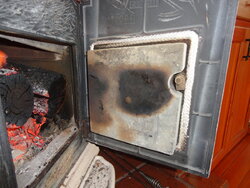I have a 2001 Waterford Ashling that has a cracked cast door part called the side door protection plate. This will be the second time it has cracked and had to be replaced. Lehman's wants $100 + shipping, and a 3-6 month wait to get it from Ireland. I don't have an issue with Lehman's, I doubt this is a big money maker for them. I was wondering if I can have a local fabricator make the part out of steel. The part does take on full woodbox heat and presumably protects the exterior door from becoming a safety hazard should anyone accidentally touch it. Would a steel part warp immediately? Would the exterior door itself warp? Any thoughts on durability or something else I am missing anything else?
Attachments
Last edited:


